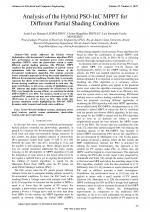| 2/2022 - 4 |
Analysis of the Hybrid PSO-InC MPPT for Different Partial Shading ConditionsLEOPOLDINO, A. L. M. |
| Extra paper information in |
| Click to see author's profile in |
| Download PDF |
Author keywords
hybrid intelligent systems, maximum power point trackers, particle swarm optimization, photovoltaic systems, solar power generation
References keywords
power(13), mppt(10), system(9), photovoltaic(8), energy(8), shading(7), partial(7), systems(6), swarm(6), tracking(5)
Blue keywords are present in both the references section and the paper title.
About this article
Date of Publication: 2022-05-31
Volume 22, Issue 2, Year 2022, On page(s): 29 - 36
ISSN: 1582-7445, e-ISSN: 1844-7600
Digital Object Identifier: 10.4316/AECE.2022.02004
Web of Science Accession Number: 000810486800004
SCOPUS ID: 85131732188
Abstract
This article addresses the Particle Swarm Optimization with Incremental Conductance algorithm (PSO-InC) performance as the maximum power point tracking algorithm (MPPT), when the photovoltaic system is under different partial shading patterns. The PSO-InC MPPT combines the global-searching capabilities of particle swarm optimization with the smoother search feature of the incremental conductance algorithm. The analysis proceeds from a systematic approach involving the system simulation for different Environmental conditions. Besides that, to accurately represent the effects of the inherent stochasticity of the PSO, diverse starting conditions were considered in each case. The main contribution, in this sense, consists of highlighting some PSC patterns that might compromise the effectiveness of the PSO, even though the average efficacy on searching the global MPP (GMPP) is over 89%. For instance, based on one of the exploited PSC patterns, one may note a decrement of the PSO effectiveness to a level as lower as 36%. This article also presents simulation results highlighting the PSO-InC MPPT dynamics under transient and steady-state conditions. |
| References | | | Cited By |
Web of Science® Times Cited: 7 [View]
View record in Web of Science® [View]
View Related Records® [View]
Updated today
SCOPUS® Times Cited: 8
View record in SCOPUS® [Free preview]
View citations in SCOPUS® [Free preview]
[1] Revolutionizing photovoltaic power: An enhanced Grey Wolf Optimizer for ultra-efficient MPPT under partial shading conditions, Ahessab, Hajar, Gaga, Ahmed, EL Hadadi, Benachir, Scientific African, ISSN 2468-2276, Issue , 2025.
Digital Object Identifier: 10.1016/j.sciaf.2025.e02586 [CrossRef]
[2] Comparison of Control Configurations and MPPT Algorithms for Single-Phase Grid-Connected Photovoltaic Inverter, PRASATSAP, U., NERNCHAD, N., TERMRITTHIKUN, C., SRITA, S., KAEWCHUM, T., SOMKUN, S., Advances in Electrical and Computer Engineering, ISSN 1582-7445, Issue 2, Volume 23, 2023.
Digital Object Identifier: 10.4316/AECE.2023.02007 [CrossRef] [Full text]
[3] Improved MPPT of solar PV Systems under different Environmental conditions utilizes a Novel Hybrid PSO, Yousaf, Muhammad Zain, Koondhar, Mohsin Ali, Zaki, Zaki A., Ahmed, Emad M., Alaas, Zuhair Muhammed, Mahariq, Ibrahim, Guerrero, Josep M., Renewable Energy, ISSN 0960-1481, Issue , 2025.
Digital Object Identifier: 10.1016/j.renene.2025.122709 [CrossRef]
[4] Research on Photovoltaic Maximum Power Point Tracking Control Based on Improved Tuna Swarm Algorithm and Adaptive Perturbation Observation Method, Li, Xianqi, He, Ye, Li, Maojun, Energies, ISSN 1996-1073, Issue 12, Volume 17, 2024.
Digital Object Identifier: 10.3390/en17122985 [CrossRef]
[5] RETRACTED ARTICLE: Experimental design and analysis of advanced three phase converter for PV application with WCO-P&O MPPT controller, Krishnaram, K., Sivamani, S., Alaas, Zuhair, Ahmed, M. M. R., Senthilkumar, S., Raj, S. Antony, Scientific Reports, ISSN 2045-2322, Issue 1, Volume 14, 2024.
Digital Object Identifier: 10.1038/s41598-024-61856-z [CrossRef]
[6] A critical review on advanced reconfigured models and metaheuristics-based MPPT to address complex shadings of solar array, Mishra, Vijay Laxmi, Chauhan, Yogesh K., Verma, K.S., Energy Conversion and Management, ISSN 0196-8904, Issue , 2022.
Digital Object Identifier: 10.1016/j.enconman.2022.116099 [CrossRef]
Disclaimer: All information displayed above was retrieved by using remote connections to respective databases. For the best user experience, we update all data by using background processes, and use caches in order to reduce the load on the servers we retrieve the information from. As we have no control on the availability of the database servers and sometimes the Internet connectivity may be affected, we do not guarantee the information is correct or complete. For the most accurate data, please always consult the database sites directly. Some external links require authentication or an institutional subscription.
Web of Science® is a registered trademark of Clarivate Analytics, Scopus® is a registered trademark of Elsevier B.V., other product names, company names, brand names, trademarks and logos are the property of their respective owners.
Faculty of Electrical Engineering and Computer Science
Stefan cel Mare University of Suceava, Romania
All rights reserved: Advances in Electrical and Computer Engineering is a registered trademark of the Stefan cel Mare University of Suceava. No part of this publication may be reproduced, stored in a retrieval system, photocopied, recorded or archived, without the written permission from the Editor. When authors submit their papers for publication, they agree that the copyright for their article be transferred to the Faculty of Electrical Engineering and Computer Science, Stefan cel Mare University of Suceava, Romania, if and only if the articles are accepted for publication. The copyright covers the exclusive rights to reproduce and distribute the article, including reprints and translations.
Permission for other use: The copyright owner's consent does not extend to copying for general distribution, for promotion, for creating new works, or for resale. Specific written permission must be obtained from the Editor for such copying. Direct linking to files hosted on this website is strictly prohibited.
Disclaimer: Whilst every effort is made by the publishers and editorial board to see that no inaccurate or misleading data, opinions or statements appear in this journal, they wish to make it clear that all information and opinions formulated in the articles, as well as linguistic accuracy, are the sole responsibility of the author.



